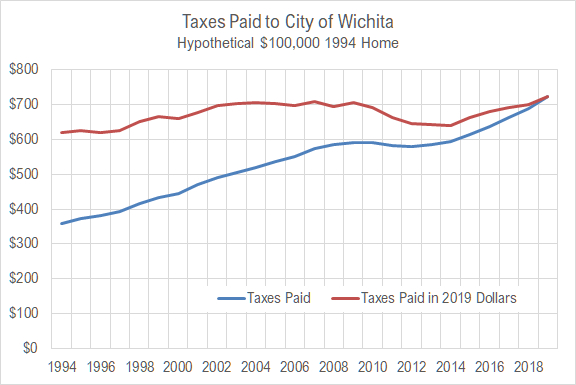The City of Wichita property tax mill levy rose for 2019.
In 1994 the City of Wichita mill levy rate — the rate at which real and personal property is taxed — was 31.290. In 2019 it was 32.721, based on the Sedgwick County Clerk. That’s an increase of 1.431 mills, or 4.57 percent, since 1994. (These are for taxes levied by the City of Wichita only, and do not include any overlapping jurisdictions.)

The rate for 2019 was up by 0.17 percent from 2018 and follows three years of virtually no change.

The Wichita City Council does not set the mill levy rate. Instead, the rate is set by the county based on the city’s budgeted spending and the assessed value of taxable property subject to Wichita taxation.
While the city council doesn’t have direct control over the assessed value of property in its jurisdiction, it does have control over the amount it decides to spend. 1 As can be seen in the chart of changes in the mill levy, the city usually decides to spend more than the mill levy is likely to generate in taxes. Therefore, the mill levy usually rises. 2

It is more common for the mill levy to rise rather than to fall. In those years, the council does not take responsibility for the increase, insisting that the rate has not gone up, or that the rate is stable, or that an increase isn’t the council’s fault.
An increase of 4.57 percent over more than two decades may not seem like much of an increase. But this is an increase in a rate of taxation, not tax revenue. As such, it is not appropriate to adjust for inflation.
Inflation, however, does play a role in tax revenue. As property values rise, property tax bills also rise, even if the mill levy rate is unchanged. In Wichita, the taxes on a hypothetical home worth $100,000
The total amount of property tax levied is the mill levy rate multiplied by the assessed value of taxable property. This amount usually rises each year, due to these factors:
- Appreciation in the value of existing property
- An increase in the amount of property
- Spending decisions made by the Wichita City Council
Application of tax revenue has shifted

The allocation of city property tax revenue has shifted over the years. According to the 2010 City Manager’s Policy Message, page CM-2, “One mill of property tax revenue will be shifted from the Debt Service Fund to the General Fund. In 2011 and 2012, one mill of property tax will be shifted to the General Fund to provide supplemental financing. The shift will last two years, and in 2013, one mill will be shifted back to the Debt Service Fund. The additional millage will provide a combined $5 million for economic development opportunities.”
In 2018 the city budget held this regarding the debt service fund: “In both 2013 and 2014, 0.5 mills were shifted back to the Debt Service Fund.”
Taxes a homeowner pays
Following, a chart showing the taxes paid to the City of Wichita for a hypothetical home. This includes changes in the value of the home (based on U.S. Federal Housing Finance Agency, All-Transactions House Price Index for Wichita, KS (MSA) [ATNHPIUS48620Q]) and inflation (based on Consumer Price Index Series II: CUUR0000SA0, U.S. city average, All items, Base Period 1982-84=100, Bureau of Labor Statistics). Click for larger versions.
—
Notes
- Although the city often grants property tax abatements at its discretion, thereby effectively removing that property from the tax rolls. ↩
- Mill Levy Facts, City of Wichita 2020 — 2021 Proposed Budget. “First, the City (the taxing district) arrives at a total amount for expenditures in the taxing funds. In Wichita these funds are the General Fund and the Debt Service Fund. After expenditure totals are known, all other revenue sources (non-property taxes and fees) are subtracted. The remainder is the amount to be raised from ad valorem (property) taxes. … The tax levy rate is calculated by dividing the total revenue to be obtained from property taxes by the total assessed value for the taxing district.” ↩
